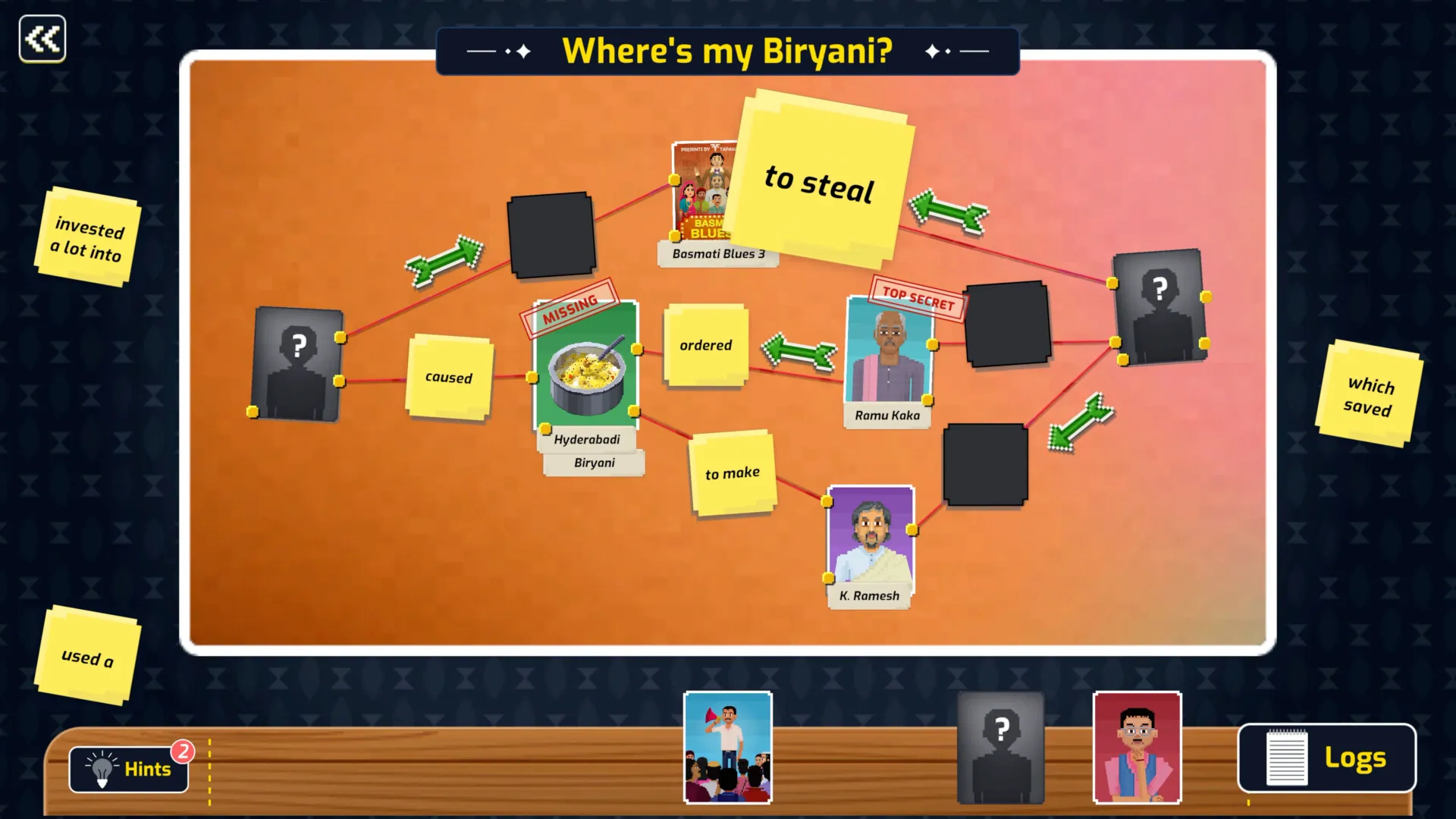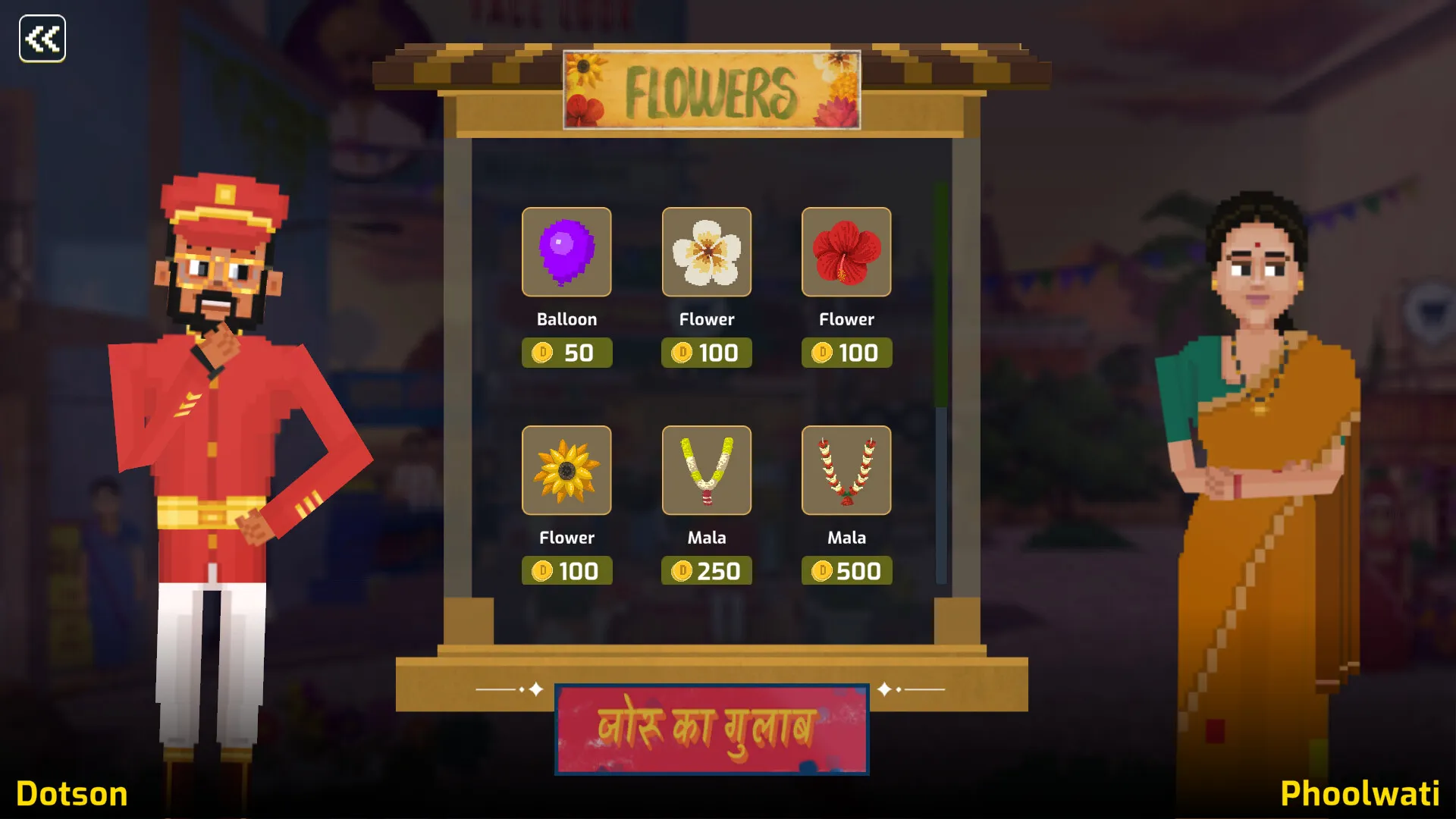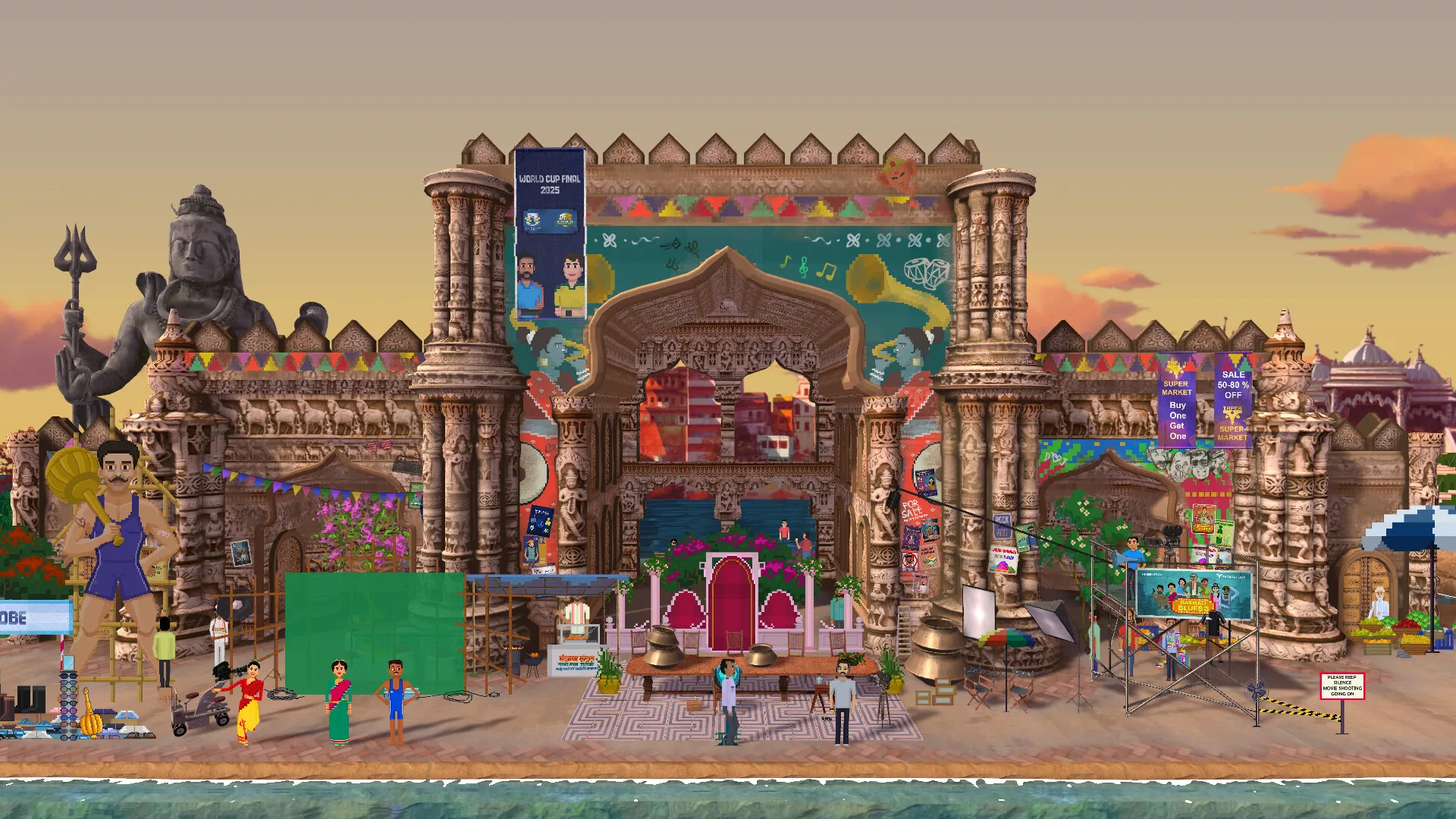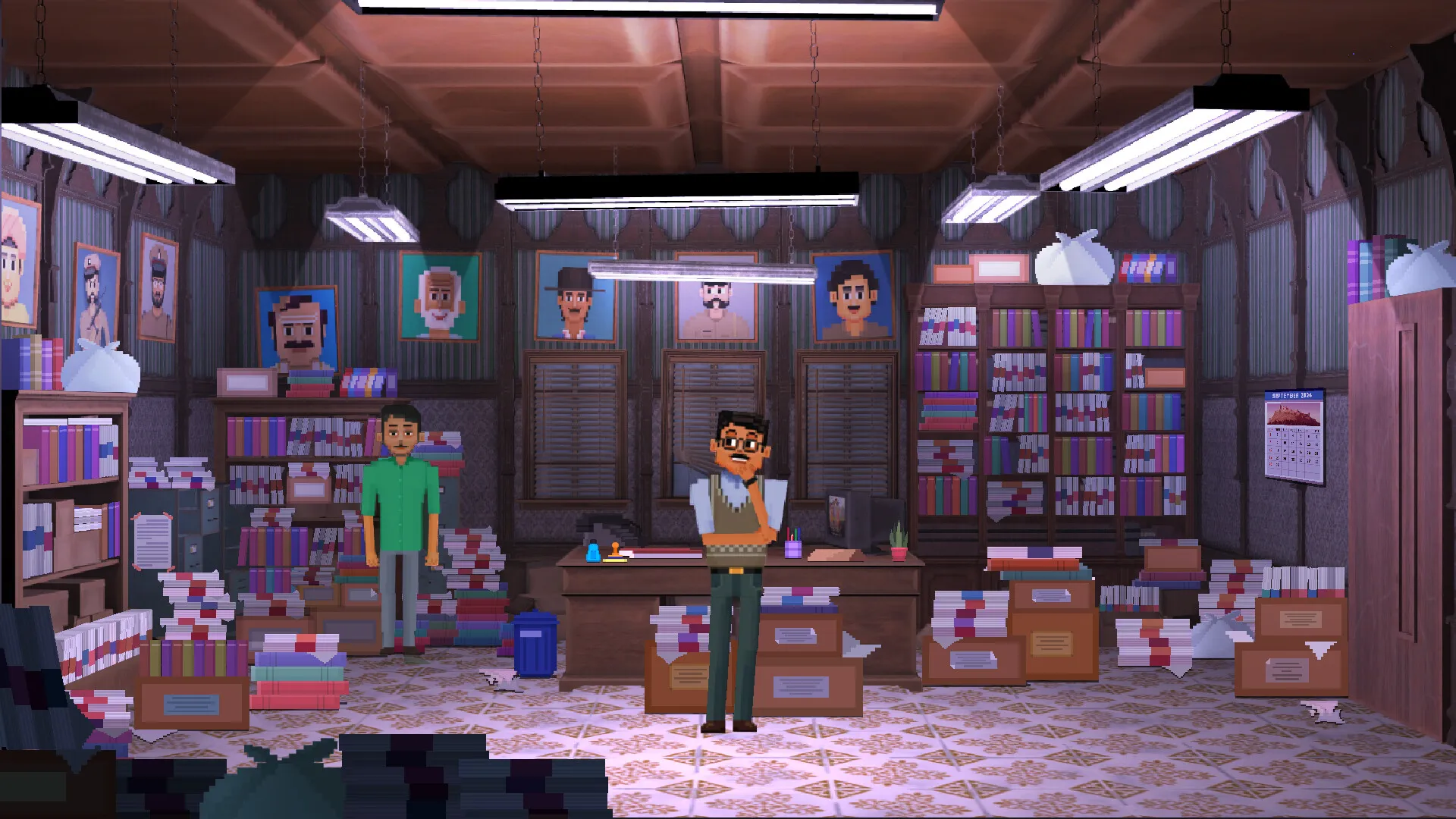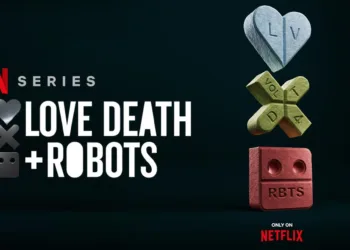Detective Dotson drops you into a side-scroll mystery set against the roar and clatter of modern Indian streets. You play Dotson, an earnest amateur sleuth bent on uncovering what really happened to his father. The game unfolds through short cases—a pink-dyed dog, a stolen biryani—that gradually stitch together a larger, more personal investigation.
Masala Games pairs playful mechanics with narrative hooks. You barter coins for gossip, tackle hidden-object challenges to unlock clues, and assemble evidence on a literal pinboard. Each interaction feels alive: a temple bell chimes in the background, vendors shout in Hindi, and Dotson’s sprint animation shifts into gleeful skips when he’s hot on a lead.
This side-scroll structure isn’t just a stylistic choice. It mirrors how memory and community gossip shape the plot: moving left or right through alleys and balconies echoes how Dotson traces connections between suspects. The short cases pace discoveries in digestible bursts, giving casual players quick wins while inviting dedicated sleuths to pore over every pixel.
By weaving cultural details—rickshaws whizzing by, trash-pickup rewards, impromptu Holi powder fights—into the main narrative, Detective Dotson turns its urban backdrop into a character of its own. As Dotson unravels small mysteries, the city speaks through its sounds, its people, and its hidden corners, leaving you to wonder which alley will yield the next vital clue.
Streets That Whisper: Dot City’s Tapestry of Life
Dot City unfolds like a living scrapbook, where every cobblestone and chatter loop feels integral to both story and gameplay. You’ll notice early on how gossip fuels your investigation—an elderly neighbour’s car repair at 4 pm becomes a clue because someone saw Dotson slip past, and that snippet of conversation sparks the next lead. This “snitch culture” isn’t window dressing; it drives the barter system. Trading coins for gossip feels organic when you’ve absorbed the rhythms of the neighbourhood.
Visually, Masala Games stitches 2D pixel art over discreet 3D models, creating a blend of nostalgia and depth. Think of it as similar to how Stardew Valley layers pixel sprites on tilting light shafts, but here the focus is on temple facades, roadside cigarette carts and ornate rickshaws crafted from scratch. Each asset carries cultural weight: a line of marigold garlands or a faded Bollywood poster anchors you in an India that doesn’t pretend to be postcard-perfect.
Audio reinforces this authenticity. Multilayered Hindi chatter overlaps with equally textured soundtrack cues from Nikhil Rao—tabla pulses cue pivotal moments, while subtle rock guitars underscore quiet discoveries. In much the same way Kentucky Route Zero uses field recordings to ground its surreal story, Detective Dotson uses sound to heighten every eureka moment on your evidence board.
Interactivity extends to the environment. Tossing litter into bins isn’t just civic virtue; it rewards you with coins or hints, reinforcing the game’s theme of community upkeep. Meanwhile, subtle background secrets—like a hidden coin tucked behind a crate or a bird nest pixel-art easter egg—invite you to slow down and explore. That sense of discovery underscores how world design and narrative intertwine: Dot City isn’t merely wallpaper, but an accomplice in every twist and turn of Dotson’s journey.
Mechanics That Speak Volumes
Detective Dotson’s mechanics never feel tacked on—they’re woven into the narrative fabric. Traversing Dot City as a side-scroller recalls classic puzzle-platformers like Link’s Awakening, yet climbing balconies and hopping ledges adds a light sense of verticality. When Dotson dashes, his sprite breaks into a joyful skip, a small flourish that underscores his optimistic drive. That animation quirk reminds us that movement here isn’t just functional; it injects character into every corridor and back alley.
Conversation drives investigation. Instead of monologues, NPCs demand an item or coin before they’ll share gossip. Floating icons above their heads translate real-world social cues into gameplay: a vendor wants a picture of a mango leaf, a nosy auntie needs sweets. This barter system transforms every chat into a two-way exchange, mirroring the give-and-take of detective work. It feels more dynamic than simply selecting dialogue options, and it encourages exploration beyond rote fetch quests.
Mini-games serve as social currency rather than filler. Hidden-object sequences freeze the world in pixel-perfect detail—some items blend so subtly into brickwork that you pause to admire the art. Contrast this with the rhythm-dance challenges: they inject energy but sometimes interrupt pacing when timing windows feel narrow. Cricket wagering offers tension, though the bat-angle mechanics can frustrate at higher stakes, turning what should be a light diversion into an accidental test of patience.
Costume changes unlock new paths. As a sadhu, Dotson’s mind-reading ability highlights overheard snippets; donning a local cop uniform grants access to gated zones. These disguises aren’t mere skins—they reframe interactions and gatekeep both narrative and geography. Watching bystanders react (or ignore) Dotson’s levitation trick reveals how social roles shape information flow.
Underpinning it all is a simple economy. Coins earned by cleaning litter or nailing mini-games fuel your bartering power. Betting on cricket adds a risk-reward dimension reminiscent of Yakuza 0’s amusement arcades, while trash-collection reminders evoke the civic tasks of Animal Crossing. Choosing where to spend—or gamble—your resources poses subtle narrative choices: do you invest in a clue that brings you closer to your father’s case, or chase quick cash in a side diversion?
By blending these systems with story beats, Detective Dotson crafts gameplay that feels as memorable as its twisty mysteries—inviting you to ponder how every mechanic reinforces Dotson’s world and his relentless optimism.
Piecing Together Truths: Narrative Threads and Deduction
Detective Dotson’s story structure thrives on episodic momentum. You begin with lighthearted cases—a dog dyed pink, a stolen biryani on a film set—each serving as a playful tutorial in investigation. As in Return of the Obra Dinn, small mysteries build your detective instincts before a deeper narrative emerges. By the third or fourth case, the stakes escalate: whispered gossip leads to hidden crime scenes, and petty thefts morph into clues about Dotson’s father’s fate. This gradual ramp-up feels deliberate, like chapters in a cult mystery novel, rewarding players who linger over each detail.
Central to that unfolding is the evidence board. A virtual pinboard laden with photos, Post-it notes and red-thread connections evokes classic crime dramas and titles such as LA Noire. Yet here, placing motive, means and opportunity relies on trial and error more than pure logic. Occasionally you’ll drag clues into place only to guess your way forward, which can interrupt narrative flow. Still, that tactile assembly invites an emotional investment—every linked thread feels like a small victory.
The case log and dialogue transcripts function as your digital memory. Conversation snippets hover beside the board, but constrained window size forces constant scrolling. Unlike the seamless journal in Heaven’s Vault, Dot City’s log demands pausing the board to retrace steps, a friction that can slow pacing when you most crave momentum.
Pacing shifts between breezy fetch quests—picking up village litter for coins—and sudden suspense as Dotson uncovers darker secrets. A Holi festival sequence bursts with color and cacophony, punctuating quieter detective work with joyful chaos. These tonal shifts mirror the duality of indie gems like Night in the Woods, where whimsy and weight coexist.
Voice and character drive much of the emotional resonance. Dotson’s unshakable optimism—his dream of Bollywood heroism—lends charm to every alleyway exchange. Nosy aunties wield gossip like weapons; market vendors balance humour with hidden motives. In this cast of neighbours, even the absentee father becomes a narrative echo, pulling Dotson (and the player) deeper into a community that’s as much suspect as ally.
As each thread intertwines, one wonders how far Masala Games will push this blend of interpersonal drama and playful crime—could a future update reveal new mechanics that make deduction as effortless as conversation?
A Symphony of Pixels and Sound
Detective Dotson’s visuals strike a compelling balance between nostalgia and detail. Temple interiors brim with tiny pixel garlands and carved pillars, while market stalls overflow with crates, signage and stray litter. The game’s colour palette—saffron marigolds, turquoise shop fronts and ochre walls—captures India’s warmth in every frame, akin to how Stardew Valley uses pastel hues to evoke a lived-in world.
Animation feels mostly smooth. Dotson’s jog transforms into a buoyant skip when he’s on a lead, and climb-and-jump sequences are fluid. Yet occasional clunky transitions—NPCs phasing through walls or rickshaws clipping into crates—remind players this is an indie effort. These glitches, while jarring, mirror the charm of low-budget gems like Celeste, where rough edges underscore genuine passion.
Cutscene voice acting brings characters to life, even when recording quality dips into amateur territory. Hearing a vendor’s tinny shout or a neighbour’s muffled whisper can break immersion, but the sincerity in each line often wins you over, much as early Oxenfree demos did despite rough audio.
Musically, Nikhil Rao’s fusion score weaves tablas and guitar riffs under layers of street ambience. Vendor calls, temple bells and ambient chatter loop seamlessly, giving the city a pulse that feels alive. These environmental loops echo the immersive design of Kentucky Route Zero, where soundscapes become narrative threads. As Dotson darts through alleys, one wonders how refining these audio textures further could deepen the sense of place.
Rough Edges Under the Microscope
Even the most charming indie can’t hide technical hiccups. Detective Dotson sometimes sends NPCs floating mid-conversation or vanishing entirely, while hidden-object puzzles occasionally lock up, forcing a manual restart. These visual anomalies break immersion, recalling the jank of early Undertale builds—endearing but disruptive.
Controls generally feel sharp—Dotson’s parkour leaps and dialogue prompts respond without lag—but the cricket mini-game’s bat-angle mechanic can misread inputs, and scraps-of-paper puzzles scatter pieces unpredictably, testing patience more than puzzle-solving skill.
The user interface keeps clues readable, with clear iconography on the evidence board and legible case-log text. Yet the transcript window’s modest size demands constant scrolling, which can stall momentum when you need quick reference.
Across PC, Linux and macOS, frame-rate remains stable, with only the occasional dip during crowded festival scenes. As Masala Games pushes future patches, addressing these stutters could sharpen an already vibrant experience—raising the question of how much polish this world can absorb while retaining its handmade charm.
Echoes Beyond the Case Files
At roughly four to five hours, Detective Dotson’s core story sits neatly between a long weekend and a single evening session. Optional diversions—hidden-object hunts and trash-collection quests—add pockets of reward without stretching sessions into chores.
Looking ahead, a free second chapter in June 2025 promises fresh mysteries and expanded mechanics, hinting at deeper worldbuilding. Replay options remain sparse once every clue is pinned, yet the game’s colourful first impression lingers. As Masala Games unfolds Dotson’s next adventure, one wonders how much richer the city’s undercurrents will become when rumors turn into new revelations.
Worth the Entry Ticket?
At INR 500 (roughly US $20), Detective Dotson offers a concise yet rich experience on PC, Linux and soon Xbox. Its minimal tutorials let players dive straight into dialogue and exploration, making mechanics approachable for newcomers while still rewarding sleuths hungry for detail.
Cultural touches—from bargaining at street stalls to ambient Hindi chatter—resonate with Indian players and invite global audiences into an authentic portrayal of urban life. Early options for adjustable text sizes hint at inclusivity, and colour-blind support may follow, broadening appeal. As indie adventures seek to balance ambition and accessibility, Dotson stands as a case study in inviting everyone to sleuth.
The Review
Detective Dotson
Detective Dotson charms with vibrant pixel streets and engaging mystery loops, its narrative and playful mechanics weaving an authentic portrait of Indian life. Technical glitches and brief runtime leave moments wanting more, but its heart and humor ensure each case feels worthwhile.
PROS
- Vibrant pixel art captures urban India with memorable detail
- Barter-driven investigations keep dialogue loops engaging
- Evidence board offers tactile clue-connecting fun
- Fusion soundtrack and ambient chatter ground the world
- Disguises unlock fresh narrative and exploration paths
CONS
- Occasional visual and mini-game glitches disrupt flow
- Evidence log window feels cramped during intense sessions
- Cricket and rhythm mini-games can misread inputs
- Narrative board sometimes relies on guesswork over logic








































